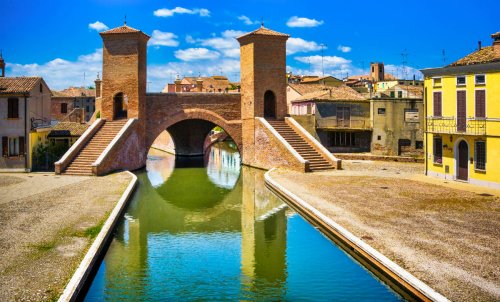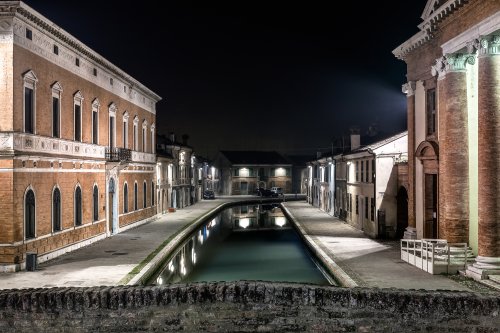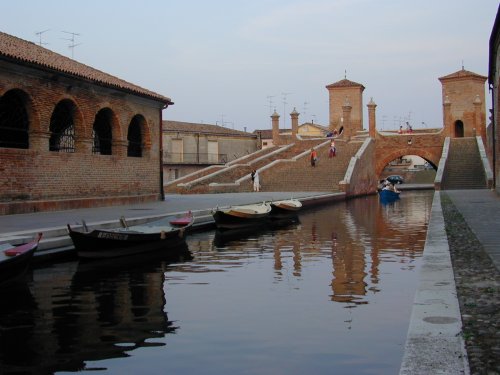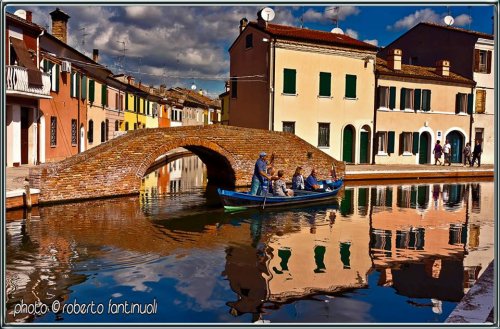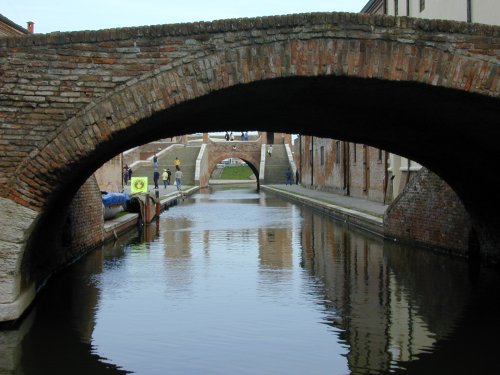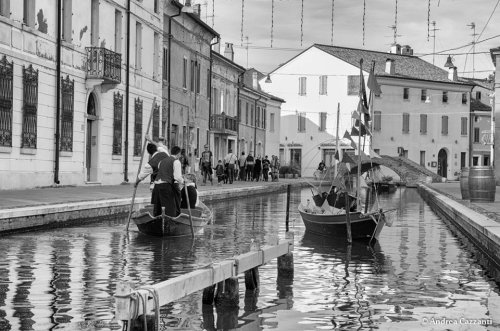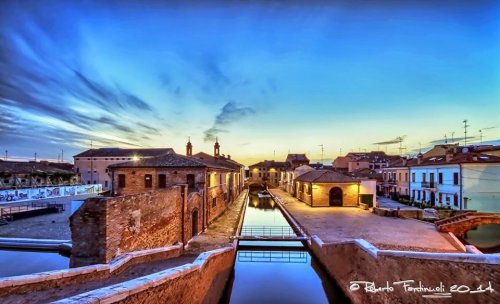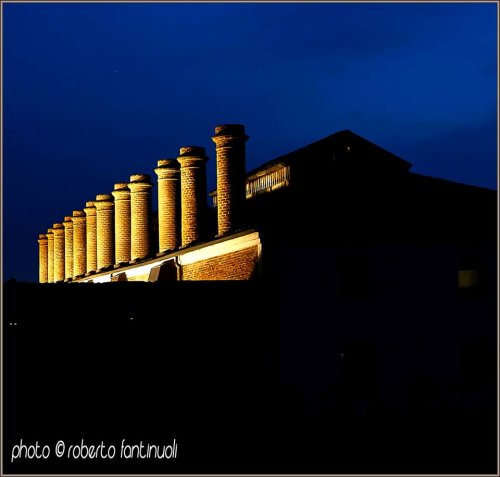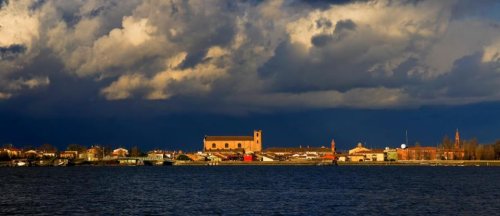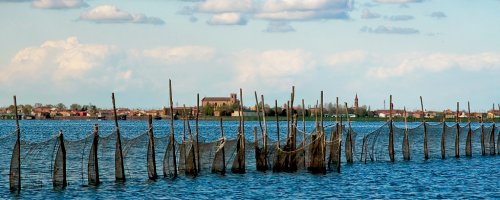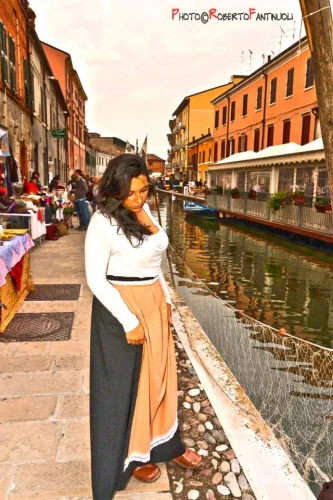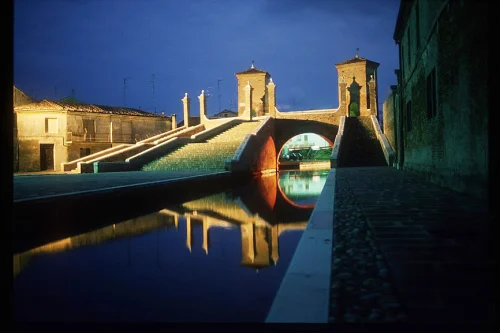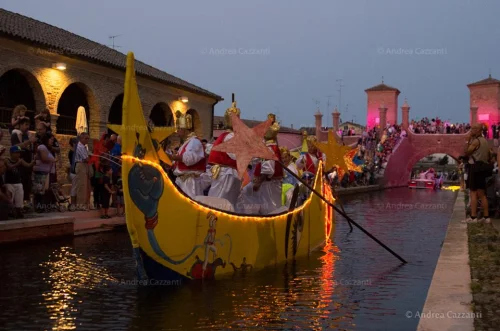Comacchio conserves intact the characteristics of a lagoon city, with its waters that run the length and breadth of the city and at a certain point surround it as in the past, when it could only by reached by boat. This was up until 1821, in which year the city, which was spread over thirteen islands was joined to the mainland. Instead of the gondole and Venetian motor boats we find characteristic local boats in many different colourful versions. The boat, at Comacchio, was a means of transportation and work for everyone.
Here the local Bridge of Sighs is the "Trepponti" (3 Bridges), an authentic emblem of the place, built by Cardinal Giovan Battista Pallotta in the context of the general reconstruction of the city. The building was erected in about 1638 by the Capuchin monk Giovanni Pietro of Lugano from drawings by the architect Luca Danese of Ravenna, this is a meeting point for the navigable Pallotta canal and the centre of the city, where it breaks up the internal waterways into a network of canals. The bridge has five broad stairways (three at the front and two at the back) with rounded arches, that the visitor can climb to reach the summit in stone from nearby Istria.
From the "Trepponti" bridge, an ideal place of observation, one can appreciate the perfect symmetry of the gaily painted low houses of the city, that are reflected in the canals, along which boats of various sizes are parked. The house usually has an archway through which one reaches the living quarters on the first floor. At the back a long, narrow courtyard extends as far as the canal at the back. Between two rows of houses we find the characteristic internal numbering along a kind of narrow alleyway or entry that leads to one of the many canals.
It is possible to visit the old city centre on one of the typical local boats, that offer free transport. We start at the monumental "Trepponti bridge" and go straight to the spectacular "Ponte delle Carceri" (Prison Bridge) also known as the "Ponte degli Sbirri" (Policemen Bridge), also built by Luca Danese at the request of Cardinal Pallotta at about the same time as the other. In the same period the nearby prison, which is now undergoing extensive restoration and transformation, was built.
Next to the old prison building stands the Bellini Palace, a typical example of nineteenth century architecture for the nobility (1866-70), home of this aristocratic and important Comacchio family. The rectangular floor plan consists of two floors and an spacious attic, which holds the Comacchio historical archives. The sumptuous halls on the ground floor house the local modern art gallery, where during the last few years a number of exhibitions on national and international levels have been held (Dioniso, Fortuna Maris, Two Women of Ancient Italy and others). The so-called noble floor (the middle floor) holds the city's public library "L.A. Muratori".
Near Bellini Palace we find the Roman ship of the Ponti canal, brought to light at Comacchio in July 1981, with all its precious cargo still on board. Beside the "Ponte delle Carceri" and in front of Bellini Palace is the magnificent building of the old Saint Camillo hospital, built in the eighteenth century. Work on this began in 1778 and ended in 1784. It was Cardinal Francesco Carafa who ordered it built. In the façade, the central part and the doors are set off by four enormous columns in brick topped with triangular tympanums. Endowed with two square bell towers, it included, on the left-hand side, the small chapel of St. Peter. Since 1970 this has ceased to be used as a hospice for the sick and in the near future it is going to be used for Human Culture Museum of the Po Delta.
Towards the city centre, between Ugo Bassi square and Folegatti square, are the Clock Tower and the Merchant Arcade or Public Granary. Today the clock in the tower still strikes the hours. It was probably erected about 1330, but it suddenly collapsed on March 22, 1816 for unknown reasons in the early hours of the morning, fortunately without killing anybody. In 1824 digging started for the foundations and the basement in stone from Istria, to form an irregular octagon resting on a square base. At the centre of the Tower a niche was inserted in 1825 to hold a statue of the Blessed Virgin of the Visitation, opera of the Ferrara artist Francesco Vidoni. After in 1850 a marble sundial in was put on the Tower. The Merchants' Arcade was constructed by Cardinal Giacomo Serra in 1621 as a warehouse for grain for the poor of Comacchio and still today is frequently used as a meeting place for the townspeople. It has a rectangular floorplan with marble columns. In 1751 the ceiling collapsed, causing the death of a visitor from Bologna, while in 1843, the Austrian government had the floor paved in stone. Until the middle of the last century, the Stone Bridge stood between the Arcade and the Tower, under which the boats passed on their way through the city.
Continuing towards the west we arrive at the Dome or Cathedral of St. Cassiano, Patron Saint of the city. The magnificent religious building which has been renovated several times, goes back as far as the VIII century AD. While the original cathedral had three naves, the present cathedral had its first stone laid in 1659, and has a single nave with twelve lateral chapels. At its side was the bell tower, which was built in 1751 but toppled to the ground in 1757.
Going along Street Via Mazzini one arrives at the Capuchin Arcade, which has 142 arches supported by as many marble columns. The Arcade reaches as far as the Sanctuary of the Royal Court, which is dedicated to a highly venerated image of the Madonna. The history of the Sanctuary is lost in the mists of time (the earliest mention of it in historical documents goes back to the tenth century). The present building is from the second half of the seventeenth century. Inside, the nave is roofed with cross vaults set on pilaster strips, whilst on the right-hand side can be found the intercommunicating chapels.
Adjoining the Sanctuary is the Marian Museum of modern sacred art, that gathers precious works produced by many great artists ranging from Sepo to Remo Brindisi.
The tour of the Churches of the lagoon city with a visit to the Church dedicated to Saint Rosario, located in Street Via Sambertoio (1618), which has one nave with four side chapels facing one another. Then the older Church of the Carmine, to be found at the side of the Pizzetti Bridge and in front of the Carmine Bridge, which goes back to XVII century, and this also has one nave with a semicircular apse.
Only some ruins are left of the Monastery of Saint Agostino, to be found at the end of Corso Garibaldi. The origin of this important religious monastery, later transformed into a fort when the Austrian troops took it over as a garrison, go back to the VII century, but the bell tower was built only in the XVII century.
closed on Mondays
accessible
- by car - take the Ferrara - Porto Garibaldi clearway
- by coach - Ferrara - Lidos of Comacchio coach route - phone 0532 599492
The museum is dedicated to the roman ship of Comacchio, an important archaeological discovery made in 1981 in the locality of Ponti Canal, a few kilometres from the lagoon town.
From the imperial era (end of the 1st century BC), the ship was intended for maritime and river trade. It left a port in the Mediterranean and was due to go up the Po to reach the inland markets of the plain when it was shipwrecked, probably because of a tidal wave and grounded near the mouth of the river. The ship was rapidly covered in silt and this allowed its cargo to be conserved. It is now exhibited in the rooms of the museum together with the hull in an adjacent pavilion-laboratory.
On the ground floor we can see objects and tools intended for on board work and the running of the ship, next to these are reconstructions, in scale, of the original and present day structure of the ship. On the first floor the domestic and trade cargoes and the passengers' belongings are kept.
